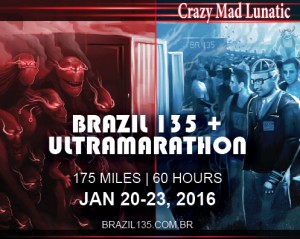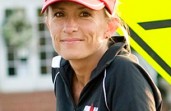 Days before the Lake Anna Triple IRON, Chuck Schultz, 40, was in the hospital and on antibiotics dealing with a Methicillin-resistant Staphylococcus aureus (MRSA) infection he contracted in his leg during his training for his first triple IRON. While the pain was excruciating, Schultz was also having some other issues. The antibiotics constipated him and he hadn’t been able to go to the bathroom for days. All the time on his back in the hospital and then the trip in the car from IL to VA drastically affected his routine.
Days before the Lake Anna Triple IRON, Chuck Schultz, 40, was in the hospital and on antibiotics dealing with a Methicillin-resistant Staphylococcus aureus (MRSA) infection he contracted in his leg during his training for his first triple IRON. While the pain was excruciating, Schultz was also having some other issues. The antibiotics constipated him and he hadn’t been able to go to the bathroom for days. All the time on his back in the hospital and then the trip in the car from IL to VA drastically affected his routine.
So Schultz toed the line of the Lake Anna Triple IRON in some discomfort.
Despite these setbacks, Schultz persevered. He had done a lot of sleep deprivation training, ran numerous nights in the dark and trained with Kamil Suran, who would go on to win the Triple IRON and smash the record. Schultz’ nutrition during the race he described as “flawless,” and while there was some discomfort—he was finally able to go to the bathroom about 300 miles into the bike. With another 36 miles to cycle and a 45-minute nap under his belt, Schultz went into the run portion of the triple and felt great.
And despite all this, Schultz not only finished the Triple IRON, he came in 9th.
Schultz’s Ultra Career Before Lake Anna
Schultz started his athletic career in 2001 as a cyclist and quickly progressed to century rides by the end of the year. After a time, he added running to his resume and over the years competed in three marathons. But it wasn’t until 2006 when he tried his first Olympic distance triathlon (1.5km swim, 40km bike, 10km run or .93 mile swim, 24.8 mile bike, 6.2 mile run) that his mind about completion changed. Schultz attempted the Chicago Triathlon in 2006 but DNFed in the swim.
When Schultz failed at the Chicago Triathlon, it really set him back. Determined to try to complete in the Chicago Triathlon, he joined Lifetime Fitness in December 2008 and found a community of triathletes at the pool that really helped motivate him to train. It was there that he met Kamil Suran, the winner and record breaker at the Lake Anna Triple IRON (fall 2011) and they are now training partners and good friends.
“That experience at the first Chicago Triathlon encouraged me to train seriously,” he said.
With the newly-found relationships in the gym he joined, Schultz was inspired to not only compete again at the Chicago Triathlon but to prepare for an ultra-racing career.
In August 2009, Schultz went back and completed at the Chicago Triathlon and before he had even signed up for Chicago, he signed up for the Coeur dAlene Ironman®, which he had to do a year in advance because the race sells out. In November 2009, he finished his first half iron distance. Two weeks later, he ran his first 50 miler, and it only went up from there.
“Moving up in distance was a matter of progression. After I finished Chicago, I thought that a half-iron wasnt much more so I did that. While training for those races, my triathlete friends at the health club inspired me to go for a full Iron distance the following year,” he said.
 Going from the Iron Distance to the Triple IRON
Going from the Iron Distance to the Triple IRON
Between 2009 and 2011, Schultz competed in a handful of 50-mile runs, a 100-mile run, a couple of 150 mile bike rides, a 186-mile bike ride, and a handful of half-irons.
But it didn’t stop there. Schultz watched Kamil compete in the Tampa Double IRON and something sparked within him.
“Watching Kamil compete inTampa really turned me on to these IRONs,” he said.
After Kamil did the Double he told Schultz he was going to do the Lake Anna Triple IRON, so Schultz started to secretly train for the race as well.
Training for Lake Anna
“At this point in my training, I make all my training plans. Kamil and I are great training partners because we train with the same intensity and are matched pretty well in ability. We also have the same outlook on racing. Our big training weeks at altitude in Colorado last year to prepare for the Triple was absolutely mind-boggling. Not too many people could handle that kind of volume. And we had a blast doing it. We both were well over 50 hours of training per week. We are able to push each other to our limits.”
To prepare for the running portion of the Triple IRON, Schultz competed in the Kettle 100 but DNFed. He ran the Mohican 100 two weeks later and finished; Kamil surprised him at that race and paced him his last 20 miles.
The cycling and swimming were a matter of scheduling and consistency. “It’s important to keep a good base on the bike, which helps with chaffing because it takes a while to build up your body so that chaffing is less of an issue,” he said.
The Lake Anna Triple IRON
Despite overcoming his staff infection and general discomfort, Schultz has a non-eventful swim in a full wetsuit, making sure he applied ample amounts of body glide. “Chaffing, even in swimming, can be an issue,” he said.
Once he started cycling, he was fine until the wee hours of the night when it became difficult to compete.
“On the bike (and also in the run) I’d find myself at 3:00 or 4:00 in the morning really struggling with the darkness because it wears on you. The sun is inspiring. When it came out I was a different person,” he said.
The drastic change in temperature was another issue. During the day it would get into the 60s but at night, it would drop down into the low 40s so the challenge became not only mental to make it through the night but physical as well as he had to ward off fatigue and keep moving forward.
“It got cold at night at Lake Anna. You needed to find a balance between staying warm and overheating. It was in the upper 30s and 40s at night. There was also wind coming off the lake.” he said.
Support Team
Schultz had one main person–Karen Shear, a fellow ultra athlete in his team. Shear prepared bottles, food, and did some pacing. She stayed up most of the race, even through the night. Judy, Schultz’s wife, also was available when she wasn’t filming (she was doing a documentary on the race). Schultz’s mom was also there intermittently throughout the competition.
“Karen is an experienced ultra marathoner,” Schultz said. “She knows a lot about nutrition and calories and knows me really well. She was there when I needed Advil (which was often). Karen was there for me in the dark and cold.”
And it was good Karen was there. Sometimes, Schultz would shut his eyes, drop his head and would actually sleep while running.
“When you get into that second night, you really gotta have the person by your side or you’re going to make some very bad decisions. Karen really enabled me to finish,” Schultz added.
Mental Preparation

While Schultz was competing, his wife, Judy, was filming a documentary of the Lake Anna Triple IRON. The documentary, called The Breaking Point,” will be released in the Fall of 2012. Visit www.tripleironmovie.com.
“In an ultra, your mind can be your best friend or your worst enemy. Ive seen people talk themselves out of finishing a race,” Schultz said. As far as each individual race, Schultz’ motivators change all the time. He looks for motivation anywhere he can get it. Sometimes Schultz will tell himself that no one will pass him from wherever he is on the course to the finish. To continue forward, Schultz will pretend someone is coming up behind him, which pushes him to go harder.
“Sometimes Ill calculate my splits in my head in order to distract myself. There are many little tricks I use. The best one though, is to have a friend with you that you are trying to beat.”
Schultz will tell any athlete that it takes a certain mental fortitude to do this sport. That athletes need to recognize what drives them and keeps them sustained during competition.
“I have always looked to challenge myself so when I finish a race, I wonder how much more I can handle. My mid-life crisis pushes me to not waste time and do the things I want to do. Accomplishing these races carries over into the rest of my life. I have a confidence and determination that only comes from pushing myself physically and mentally regularly,” he said.
Race Planning
Schultz will usually plan his races at the beginning of the year. Many races require athletes to sign up and pay in the Spring, for example, before they fill up. This is a big financial burden at the beginning of the year. “Between gear, nutrition, entry fees and travel, it can get expensive. Somehow, we make it work,” Schultz said.
Nutritional Balance
Nutrition during competition or training is very important. Schultz uses a mixture Hammer, Cytomax, Monster and Muscle Milk in his training or racing. The products, combinations of products and frequency, change depending on type of race, distance and intensity of racing, but in essence, Schultz prefers liquid calories when he’s out there.
Injury Prevention
Schultz used to get injured before he got serious about training. He’d sign up for a marathon, work a lot, miss key workouts and then try to ramp up mileage too quickly and get injured. With a consistent plan and a few other tricks, Schultz has been injury free for a couple of years. “Getting older does make me less flexible though. I need to stretch my back, glutes and hamstrings regularly. Supplements help with staying injury free also,” he said.
Personal Life
Schultz, who works as an electrician, has been married to his wife, Judy for 8 years. Balancing training with home life and work life is challenging in and of itself, and isn’t sure if he could do this if he and Judy had kids. “I dont know if I could do this if we had kids,” he said. “I usually peak twice during the year with my training. Judy prepares for our lives to be out of balance during those times. I have been fortunate to be flexible with work but it’s always a balancing act.”
Nonetheless, an 8th place finish in his first triple IRON was a great accomplishment, as he sets his eye on the DECA IRON.














Have you ever thought about writing an ebook or guest authoring on other blogs?
I have a blog centered on the same information you discuss and
would really like to have you share some stories/information.
I know my audience would appreciate your work. If you are even remotely interested, feel free to send me
an e mail.
Id be happy to take a look at your blog. email me at [email protected].